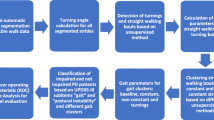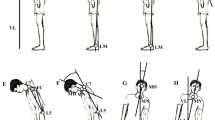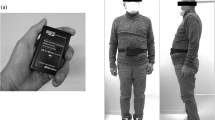Abstract
Parkinson’s disease (PD) is a neurodegenerative disease of the central nervous system that results from the degeneration of dopaminergic neurons in the substantia nigra. Abnormal gait begins in the early stage and becomes severe as the disease progresses; therefore, the assessment of gait becomes an important issue in evaluating the progression of PD and the effectiveness of treatment. To provide a clinically useful gait assessment in environments with budget and space limitations, such as a small clinic or home, we propose and develop a portable method utilizing the monocular image sequences of walking to track and analyze a Parkinsonian gait pattern. In addition, a centroid tracking algorithm is developed and used here to enhance the method of quantifying kinematic gait parameters of PD in different states. Twelve healthy subjects and twelve mild patients with PD participate in this study. This method requires one digital video camera and subjects with two joint markers attached on the fibula head and the lateral malleolus of the leg. All subjects walk with a natural pace in front of a video camera during the trials. Results of our study demonstrate the stride length and walking velocity significantly decrease in PD without drug compared to PD with drug in both proposed method and simultaneous gait assessment performed by GAITRite® system. In gait initiation, step length and swing velocity also decrease in PD without drug compared to both PD with drug and controls. Our results showed high correlation in gait parameters between the two methods and prove the reliability of the proposed method. With the proposed method, quantitative measurement and analysis of Parkinsonian gait could be inexpensive to implement, portable within a small clinic or home, easy to administer, and simple to interpret. Although this study is assessed Parkinsonian gait, the proposed method has the potential to help clinicians and researchers assess the gait of patients with other neuromuscular diseases, such as traumatic brain injury and stroke patients.






Similar content being viewed by others
References
Avidan S (2005) Ensemble tracking. IEEE Trans Pattern Anal Machine Intell 29:261–271
Benedetti M, Catani F, Leardini A, Pignotti E, Giannini S (1998) Data management in gait analysis for clinical applications. Clin Biomech 13(3):204–215
Bharatkumar A, Daigle K, Pandy M, Cai Q, Aggarwal J Lower limb kinematics of human walking with the medial axis transformation. In: Motion of non-rigid and articulated objects, 1994. In: Proceedings of the 1994 IEEE workshop on, 1994. IEEE, pp 70–76
Bilney B, Morris M, Webster K (2003) Concurrent related validity of the GAITRite® walkway system for quantification of the spatial and temporal parameters of gait. Gait Posture 17(1):68–74
Breniere Y, Cuong Do M, Bouisset S (1987) Are dynamic phenomena prior to stepping essential to walking? J Mot Behav 19(1):62–76
Chang H, C T, Lee S, Liao S, Lee H, Shih Y, Cheng H (2004) Temporal differences in relative phasing of gait initiation and first step length in patients with cervical and lumbosacral spinal cord injuries. Spinal Cord 42(5):281–289
Chen Z, Lee HJ (1992) Knowledge-guided visual perception of 3-D human gait from a single image sequence. IEEE Trans Syst Man Cybern 22(2):336–342
Chien S-L, Lin S-Z, Liang C-C, Soong Y-S, Lin S-H, Hsin Y-L, Lee C-W, Chen S-Y (2006) The efficacy of quantitative gait analysis by the GAITRite system in evaluation of parkinsonian bradykinesia. Parkinsonism Relat Disord 12(7):438–442
Cho C, Kunin M, Kudo K, Osaki Y, Olanow CW, Cohen B, Raphan T (2010) Frequency-velocity mismatch: a fundamental abnormality in parkinsonian gait. J Neurophysiol 103(3):1478–1489
Comaniciu D, Ramesh V, Meer P (2000) Real-time tracking of non-rigid objects using mean shift. In: IEEE computer society conference on computer vision and pattern recognition (CVPR’00), 2000. Published by the IEEE Computer Society, p 2142
Crenna P, Carpinella I, Rabuffetti M, Rizzone M, Lopiano L, Lanotte M, Ferrarin M (2006) Impact of subthalamic nucleus stimulation on the initiation of gait in Parkinson’s disease. Exp Brain Res 172(4):519–532
Djaldetti R, Ziv I, Melamed E (2006) The mystery of motor asymmetry in Parkinson’s disease. Lancet Neurol 5(9):796–802
Gelb DJ, Oliver E, Gilman S (1999) Diagnostic criteria for Parkinson disease. Arch Neurol 56(1):33–39
Green RD, Guan L (2004) Quantifying and recognizing human movement patterns from monocular video images-part i: a new framework for modeling human motion. IEEE Trans Circuits Syst Video Technol 14(2):179–190
Green RD, Guan L, Burne J (2000) Video analysis of gait for diagnosing movement disorders. J Electron Imaging 9(1):16–21
Halliday SE, Winter DA, Frank JS, Patla AE, Prince F (1998) The initiation of gait in young, elderly, and Parkinson’s disease subjects. Gait Posture 8(1):8–14
Hoehn MM, Yahr MD (1967) Parkinsonism: onset, progression and mortality. Neurology 17(5):427–442
Jankovic J, McDermott M, Carter J, Gauthier S, Goetz C, Golbe L, Huber S, Koller W, Olanow C, Shoulson I (1990) Variable expression of Parkinson's disease: a base-line analysis of the DATATOP cohort. The Parkinson Study Group. Neurology 40(10):1529–1534
Jasiewicz JM, Allum JHJ, Middleton JW, Barriskill A, Condie P, Purcell B, Li RCT (2006) Gait event detection using linear accelerometers or angular velocity transducers in able-bodied and spinal-cord injured individuals. Gait Posture 24(4):502–509
Lang A, Lozano A (1998) Parkinson’s disease. Second of two parts. N Engl J Med 339(16):1130–1143
Langston JW, Widner H, Goetz CG, Brooks D, Fahn S, Freeman T, Watts R (1992) Core assessment program for intracerebral transplantations (CAPIT). Mov Disord 7(1):2–13
Martinez Martin P, Gil Nagel A, Gracia LM, Gomez JB, Martinez Sarries J, Bermejo F (1994) Unified Parkinson’s disease rating scale characteristics and structure. Mov Disord 9(1):76–83
McDonough AL, Batavia M, Chen FC, Kwon S, Ziai J (2001) The validity and reliability of the GAITRite system’s measurements: a preliminary evaluation. Arch Phys Med Rehabil 82(3):419–425
Moore ST, MacDougall HG, Ondo WG (2008) Ambulatory monitoring of freezing of gait in Parkinson’s disease. J Neurosci Methods 167(2):340–348
Morris ME, Matyas TA, Iansek R, Summers JJ (1996) Temporal stability of gait in Parkinson’s disease. Phys Ther 76(7):763–777
Morris M, Iansek R, Matyas T, Summers J (1998) Abnormalities in the stride length-cadence relation in parkinsonian gait. Mov Disord 13(1):61–69
Nallegowda M, Singh U, Handa G, Khanna M, Wadhwa S, Yadav SL, Kumar G, Behari M (2004) Role of sensory input and muscle strength in maintenance of balance, gait, and posture in Parkinson’s disease: a pilot study. Am J Phys Med Rehabil 83(12):898
Okuno R, Fujimoto S, Akazawa J, Yokoe M, Sakoda S, Akazawa K (2008) Analysis of spatial temporal plantar pressure pattern during gait in Parkinson’s disease. In: 30th annual international conference of the IEEE Vancouver, BC, 2008. IEEE, pp 1765–1768
Rosin R, Topka H, Dichgans J (1997) Gait initiation in Parkinson’s disease. Mov Disord 12(5):682–690
Selby-Silverstein L, Besser M (1999) Accuracy of the GAITRite system for measuring temporal-spatial parameters of gait. Phys Ther 79(5):S59
Sofuwa O, Nieuwboer A, Desloovere K, Willems AM, Chavret F, Jonkers I (2005) Quantitative gait analysis in Parkinson’s disease: comparison with a healthy control group. Arch Phys Med Rehabil 86(5):1007–1013
Švehlík M, Zwick EB, Steinwender G, Linhart WE, Schwingenschuh P, Katschnig P, Ott E, Enzinger C (2009) Gait analysis in patients with parkinson’s disease off dopaminergic therapy. Arch Phys Med Rehabil 90(11):1880–1886
Wen Z, Cai Z (2007) A robust object tracking approach using mean shift. In: Proceedings of the 3rd international conference on natural computation, vol 2, pp 170–174
Yang YR, Lee YY, Cheng SJ, Lin PY, Wang RY (2008) Relationships between gait and dynamic balance in early Parkinson’s disease. Gait Posture 27(4):611–615
Yilmaz A (2007) Object tracking by asymmetric kernel mean shift with automatic scale and orientation selection. In: IEEE conference on computer vision and pattern recognition, Minneapolis, MN, USA 2007
Zhiqiang W, Zixing C (2007) A robust object tracking approach using mean shift. In: International conference on natural computation, pp 170–174
Acknowledgments
The authors are grateful to Chung-Yi Wu for his technological support during this study. We are also very grateful to the volunteers who generously gave their time to assist with this research. This research is supported by the Grant Nos. 101-2622-E-010-002-CC2 and 102-2221-E-010-011-MY3 from the Ministry of Science and Technology of the Republic of China in Taiwan.
Author information
Authors and Affiliations
Corresponding author
Rights and permissions
About this article
Cite this article
Lin, SH., Chen, SW., Lo, YC. et al. Quantitative measurement of Parkinsonian gait from walking in monocular image sequences using a centroid tracking algorithm. Med Biol Eng Comput 54, 485–496 (2016). https://doi.org/10.1007/s11517-015-1335-2
Received:
Accepted:
Published:
Issue Date:
DOI: https://doi.org/10.1007/s11517-015-1335-2




